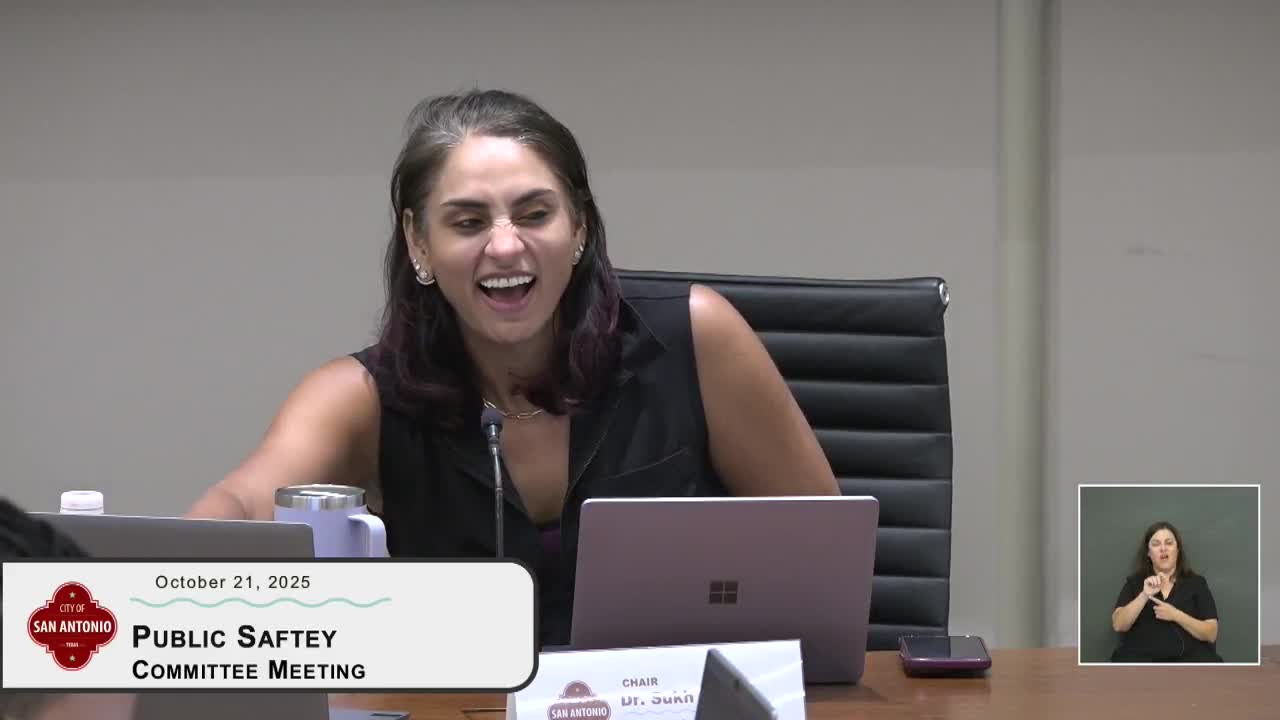City planners and police outline CPTED-focused program to reduce violent and property crime at hotspots
October 21, 2025 | San Antonio, Bexar County, Texas
This article was created by AI summarizing key points discussed. AI makes mistakes, so for full details and context, please refer to the video of the full meeting. Please report any errors so we can fix them. Report an error »

City planning staff and the police department presented the Crime Prevention Through Environmental Design (CPTED) program and examples from recent property-focused interventions aimed at reducing violent and property crimes in identified hotspots.
Brigitte (presenter listed in materials as a planning staff lead) described a three‑phase approach launched in January 2023 that starts with short-term situational strategies, moves to problem-oriented policy changes and, in focused sites, adds multiagency, place-based interventions. Staff presented case studies: two multifamily complexes where poor lighting, broken windows, obstructive landscaping and unsecured common areas were cited as contributing conditions. Recommended remedies included LED lighting, site maintenance (trim trees to six-foot sightlines), improved signage, activated common spaces, property-management engagement and, where feasible, camera installation.
Police and planners described one successful example where a community garden was installed in a hotspot; staff reported the garden provided jobs and restorative activities and contributed to a safer corridor. Presenters emphasized that outcomes vary by property ownership: public‑private partnerships, nonprofit involvement or existing funding streams (as in a previously funded public‑private redevelopment) allowed capital improvements in one case, while in private-property cases city staff said subsidies or targeted incentives would be needed to encourage upgrades without upward pressure on rents.
Councilmembers asked about scaling—how many properties can the program reasonably tackle at once—and whether funding could support multiple sites simultaneously. Staff said the program is resource intensive, usually works on a handful of the highest‑priority sites at a time, and that phase‑two and phase‑three interventions are longer-term. Councilmembers requested more detail about possible incentives for private-property owners and potential budget options; staff said they will explore options and return with a plan for prioritizing sites and potential funding models.
Committee members praised the program’s preventive emphasis and discussed extending CPTED guidance to libraries, parks and other public facilities. Staff said some pilot interior recommendations (for example, for a central library) are underway via a university study and that the planning team will coordinate with property owners, developers and the committee on next steps.
The item was informational; no committee action was taken.
Brigitte (presenter listed in materials as a planning staff lead) described a three‑phase approach launched in January 2023 that starts with short-term situational strategies, moves to problem-oriented policy changes and, in focused sites, adds multiagency, place-based interventions. Staff presented case studies: two multifamily complexes where poor lighting, broken windows, obstructive landscaping and unsecured common areas were cited as contributing conditions. Recommended remedies included LED lighting, site maintenance (trim trees to six-foot sightlines), improved signage, activated common spaces, property-management engagement and, where feasible, camera installation.
Police and planners described one successful example where a community garden was installed in a hotspot; staff reported the garden provided jobs and restorative activities and contributed to a safer corridor. Presenters emphasized that outcomes vary by property ownership: public‑private partnerships, nonprofit involvement or existing funding streams (as in a previously funded public‑private redevelopment) allowed capital improvements in one case, while in private-property cases city staff said subsidies or targeted incentives would be needed to encourage upgrades without upward pressure on rents.
Councilmembers asked about scaling—how many properties can the program reasonably tackle at once—and whether funding could support multiple sites simultaneously. Staff said the program is resource intensive, usually works on a handful of the highest‑priority sites at a time, and that phase‑two and phase‑three interventions are longer-term. Councilmembers requested more detail about possible incentives for private-property owners and potential budget options; staff said they will explore options and return with a plan for prioritizing sites and potential funding models.
Committee members praised the program’s preventive emphasis and discussed extending CPTED guidance to libraries, parks and other public facilities. Staff said some pilot interior recommendations (for example, for a central library) are underway via a university study and that the planning team will coordinate with property owners, developers and the committee on next steps.
The item was informational; no committee action was taken.
Don't Miss a Word: See the Full Meeting!
Go beyond summaries. Unlock every video, transcript, and key insight with a Founder Membership.
✓
Get instant access to full meeting videos
✓
Search and clip any phrase from complete transcripts
✓
Receive AI-powered summaries & custom alerts
✓
Enjoy lifetime, unrestricted access to government data
30-day money-back guarantee

